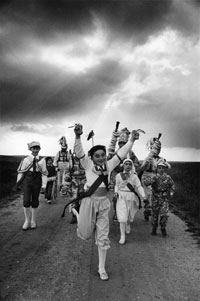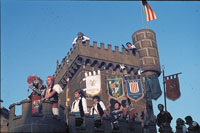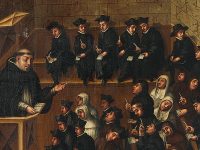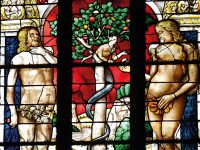
|
|
||
|
There are two basic calendar types, one showing important dates and the other showing seasonal or monthly cycles. Both these institutionalised forms portray a series of codes, revealing a qualitative conception of time. It is noteworthy that calendars also reflect real life, and these «living calendars» highlight festive periods of intense social life and experiences. In classical antiquity there was constant development of calendars and almanacs, through poems and other literary modes; this was to continue in the Middle Ages and even increase, with representative forms accessible to the illiterate population, like cloister embossments, illuminated manuscripts, and so on. In the Modern Era they gained considerable popularisation, with printed copies issued in much greater numbers than those of any other work for the general public, encompassing all social classes, and in graphic forms equally accessible to all, literate and illiterate alike. From the start, the content was defined by a period crystallised in time: a year. As a unit, this is not only distinct, but –moreover– complete to a certain extent, capable of being reproduced indefinitely following the same common pattern, and yet capable of being renewed. A cycle that invariably finishes, but on reaching the point of completion, starts anew on being slotted into a never-ending sequence. A fictional entity, which ends up giving rise to the continuous succession of time, considering both a part and the whole. As a cultural artefact, it is highly instrumental. Indeed a calendar of festivals is a real cultural device. A calendar contains mythological allusions, it is full of historical references, it is a cosmological treatise, modelled on natural patterns, it provides multiple social images, reveals a variety of images reflecting social structure, shows the timing or sequence of different economic activities, sets limits and continuities between them, serves as an onomastic reference and social classification, mirrors religious beliefs –even different faiths–, personifies moral values, portrays an individual’s biography (and the life of different organisations), and so on. Indeed, to list the analytical functions here would be too long, but this mere consideration is enough to illustrate the power and centrality of such an instrument in urban and rural cultures of Europe and, by extension, many others. Nevertheless, the calendar’s careful portrayal of naturalism is –of course– fiction, or if you prefer, a language, or rather, a tight web of overlapping and interwoven codes with notable inconsistencies which, nonetheless, neither fracture nor dissolve it. Albeit laudable, it would be naive to attempt an understanding that obeys only naturally derived units of numerical logic. Rather we find a multitude of logics (orders) following various rationalisations, often interfering with each other, and leaving unresolved conflicts that simply fade temporarily, to return next time round. None of these logics is of theoretical reasoning alone, but practical reasoning and political reasoning … because the calendar is a political instrument, no less. The construction of this institutionalised cultural instrument underwent several stages of development, at least one of objectification (with various corrections rationalised in terms of astronomical calculations) and another of generalisation (Roman composition claimed to be found everywhere). What these would appear to indicate is a constant effort to attenuate the inconsistencies. However, this has not prevented calendars from being frequently reworked by national societies or local populations, who often bestowed upon them certain subjectivity, attributing to some time periods a variety of personifications and affectations, and not only to months and days –even referred to numerically– but to hours too. Given this array of characterisations, we can talk about calendars in diverse terms. Some of the most notable differences include specific dates of importance as opposed to indefinite periods, extreme weather conditions linked to certain months depending on the hemisphere, seasons varying in duration depending on latitude, and so on. Furthermore, despite these aforementioned processes, the calendar has not been fully perfected. Often those in political power propose certain reforms. Thus, the time code always seems somewhat inadequate. |
«Calendars have been frequently reworked by national societies or local populations, who often bestowed upon them certain subjectivity»
|
|
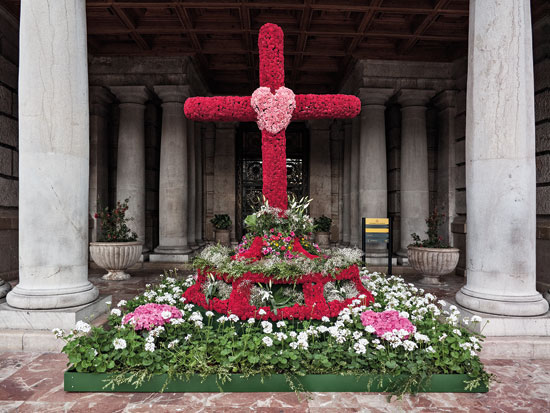 Mario Rabasco In traditional rural society, when the calendar of festivals was closely linked to the seasons and crop cycles, the month of May was celebrated as the beginning of the fertile period in the country. Currently the celebration is more closely identified with tradition and identity. The photograph shows a May Cross (Valencia). Two types of calendar There are two basic calendar configurations in Western societies (rooted in classical Rome and later incorporating medieval and Renaissance ordering and rearrangements). One outlines a series of special days –festivals– which are highlighted so as to stand out from a number of rather diffuse unmarked or common days; the other shows a limited number of time periods, which take on the form of major and minor time cycles subsumed in each other. The former is commonly found in ecclesiastical administrative documentation, zealously remarking the festivals. For instance, Roman calendars, like that from the year 354, showed not only the Roman festivals but also the dates of the depositio episcoporum or martyrum; later medieval calendars followed the same model, as did the Mozarabic ones. The latter is situated within the copious classical and medieval literature that cultivated a description of the seasons, and a list of events with their associated characteristic figures in menologies and profuse iconographic works placed inside temples and cloisters, and in illuminated manuscripts. The former seems to assume a qualitative time distinction, as if the days were marked by self-justification, and reveals an institutional determination to highlight them. The latter seems to overlie some natural order; the time cycles are ordered sets, which generate meaning for the subsets and their component units. In short, both follow the longest time cycle, that is, the annual cycle. To some extent, both configurations offer two different experiential modes of time, partly complementary and partly contrary. Festivals take on a supplementary role, marking the days lying at the interstices of the time cycles, and particularly at the moments of commencement and closure. Conversely, festivals do not fall in with the succession of recurring activities in the time cycles and represent a certain hurdle to their development, so that –in fact– they tend not to be observed or are forcibly so. The assumption is that highlighted days are to be celebrated, whether they are natural or instituted. In contrast, as shown by Duvignaud in Saharan societies, celebrations have no fixed dates but seem to happen at some point or another, without their occurrence being at risk. Thus, this fixed trait of festivals would seem to be an adopted cultural resistance and not properly ingrained in the nature of time. This dual calendar configuration, therefore, reveals an undercurrent in the conception of time, which highlights no so much its indefinite flow but rather bounded time periods, or its consistency from establishing fixed points. As Leach states, holidays have a dual profile: first they define a period, a cycle (one week is the time between one Sunday and the next), on the other hand, they simply fulfil the cycle (Sunday is what links one week to the next). This model can be shifted to larger cycles, specifically yearly cycles, in that a year is the period from one Christmas to the next; or from one Easter to the next; or from one festival to the next. As to the predominance of one or the other, nothing is predetermined. Sometimes these special dates are considered immutable, while others are moved for convenience, and this does not necessarily relate to the intensity of the celebration, revealing that the calendar is flexible and constant at the same time, both with cultural underpinnings. |
«The notion of a time cycle is clear. It refers to solar and lunar cycles, while also referring to the various climatic cycles and life cycles of plants and animals, of human life, economic activities and social events»
|
|
|
The notion of cycle The notion of a time cycle is, therefore, clear. It refers to solar and lunar cycles (perceived), while also referring to the various climatic cycles and life cycles of plants and animals. So too to the cycle of human life, and the cycles marking economic activities and social events. Although these are understood to be connected, they are on different levels or dimensions. And not all of them happen synchronously, but may do so in parallel or even overlapping each other. More relevant to the issue of rigorous objectification of cycles is this translation of dimensions, both inclusive and analogous at the same time. Calendars are seen as the cultural tools translating these dimensions. The role of festivals in the calendar is still largely a reflection, presumably programmed, of the translation of these dimensions. With rituals linked to life cycles, and those linked to economic and social cycles, being located at different times of the year, the calendar gives way to human life while simultaneously reproducing it analogically; the days give way to social life while allowing it to be projected; the seasons drive economic and social life, but also give analogous shape to a variation of temperaments, and so on. Therefore, cycles are varied in length and heterogeneous in motivation. But this seems to be a very productive system, as a set of special dates also keeps the memory of events alive and forms an annual cycle, which revives them on their anniversary. And even beyond one year, with biennial celebrations or fiftieth anniversaries, or those marking a decade, a century or millennia. As a historic code, the calendar is not only full of references, but allows us to actively highlight days, which become references to the past at a future time. An ongoing process of reflection and projection. In unfolding patterns of order in the succession of special days, the calendar seems like a palimpsest, a scroll of hidden languages, which –whether they are or nor– seem manifold. The reasoning behind septenary division of work/rest periods is not a cultural universality and its generalisation is induced. In traditional rural societies the work/leisure cycles vary in line with cyclical tasks related to crops or animal husbandry. Moreover, despite labour regulations, work/leisure cycles in modern societies allow for important variation in the service sectors, as well as in certain industries and businesses or even institutions. Regarding the monthly conformation, incongruity reveals the duplicity of widespread month names. A part of March, and another of January, September, October, November and December are not what they seem, but their numbers reveal what they were before the Julian reform. Despite the slow, painstaking work required to Christianise the calendar, the coincidence of specific dates and patterns is all too evident. The biographical metaphor adopted by Christianity has its own logic, but so too its determination to overlay or replace previous festivals. But besides that metaphor, the transformation of Corpus Christi into Corpus Mysticum links the Easter of Resurrection and of Pentecost and coincides with the spring equinox. The biographical metaphor also includes the insertion of saints on certain days, the dies natalis, of death and access to eternal life. |
«In traditional societies the work and leisure cycles vary in line with cyclical tasks related to crops or animal husbandry. Despite labour regulations, work and leisure cycles in modern societies allow for important variation»
|
|
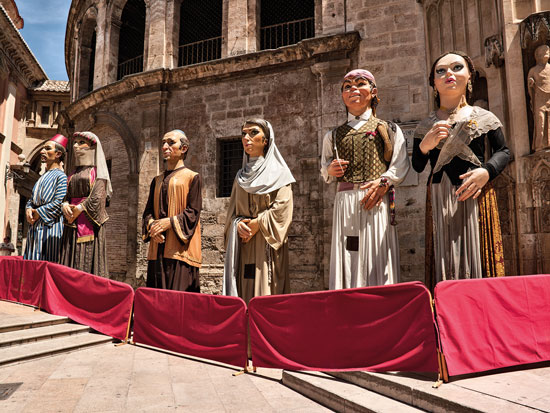 Mario Rabasco Corpus Christi is celebrated sixty days after Easter Sunday, that is, on the Thursday following the ninth Sunday after the first full moon of spring in the northern hemisphere. In many places it has been moved to Sunday to fit in with the working calendar. The picture shows Corpus Christi in Valencia. Living calendars These are some of the institutionalised calendar periods. These periods have numerous particular configurations, as societies take them to make them their own. They are living calendars, a succession of special days –festivals– that fit in with the lifestyles that adopted them, expressing their beliefs, their way of seeing the world, their ties with the past, and boosting their social life. Living calendars comprise a limited and variable number of popular festivals. In Spain today, and in the past, some populations celebrate, or celebrated, more festivals than others, a fact pointed out by themselves or by neighbouring populations. The difference is, and was, primarily to do with celebrations related to certain saints (San Antón, San Sebastián, San Blas, Santa Águeda, etc.) or to Marian shrines (Candelaria, Presentación, Natividad, etc.). But also among the variations we find that universal festivities, like Easter or Christmas, are celebrated more intensely in some regions than in others. Nowadays, the most evident differences relate to the number of days taken to celebrate the «patron saint», which is seldom a single day, but more often three days or sometimes a week or a fortnight. The holidays are unevenly distributed during the year. In the past, many rural villages had a popular festival in winter and another in summer, or a number of holidays concentrated in summer and early autumn, a pattern that is widespread today in most rural populations, with most festivals being held in the summer. In Spain, changes have taken place with people migrating from the countryside to the city, which has affected the demographics of rural areas, but as people continued to return to their hometowns to spend the holidays, the town festivals –if held at inopportune times– were moved to coincide with weekends and the summer holiday period. Popular festivals involve the whole population in general, but differ in terms of intensity and events, and the importance or hierarchy attributed to some over others. For local populations, the hierarchy of institutionalised calendar holidays is not necessarily respected in the same way. Rather, the culmination of that hierarchy is very often given to festivals, which may be celebrations of the patron saint (San José or San Bartolomé) or a Marian shrine (Virgen del Roble, Virgen de la Estrella, Virgen de la Sierra, Virgen de la Cabeza, and so on), which are of little relevance on the institutionalised calendar. Hierarchy is not necessarily respected among institutionalised festivals either, for example, the Corpus celebration is often seen as more important than Easter. The main festivities drive the annual cycle, representing a peak or climax period within it. So the other celebrations are seen as steps or stages, and in a way the cycle opens and closes them. Often summer festivals held at different times coincide with the beginning or end of crop cycles: cereal-growing regions celebrate them at the beginning or middle of the summer, while grape-growing regions celebrate the harvest at the end of summer. Nowadays, festivals held during holiday periods mark the end or the beginning of new cycles of work or school. It is not only the economic logic, but also the social logic behind festivals that often prevails over the institutionalised calendar. Congregation and meeting times sometimes involved the whole social group, while others only summoned specific social sectors: young people in particular, but also men or women, children, or shepherds, ranchers, farmers, artisans, and so on. In contemporary societies, popular festivals are organised by specific groups of people while traditional festivals are often organised by institutions, which seek recognition and social visibility. However, institutionalised festivals are often hijacked by the general public, and frequently given new names. Maybe they were originally implemented institutionally, but eventually became the property of the people in towns and cities, and often of civil society, organised in associations. The names follow popular patterns and sometimes involve a particular festive event (La Pinochada, El Vítor, La Encamisada, El Misteri, Las hogueras…) or characters (Jarramplas, Cascamorras, Taraballo, devils, Moors and Christians…), others relate to a religious figure (El Santo Voto, romería a la Fuensanta, bajada de la Virgen de los Reyes), while others still reformulate the figure (Santantonada, La Peregrina, La Santina, O Corpiño, Fiestasantos, etc.). Although festival names merely highlight the appropriation of a celebration, which not only takes on its own liturgies, but gives greater importance and significance to informal or even profane acts and practices, that are secondary to the institutionalised standard, and thereby transform them into an intense experience. Just as institutionalised calendars and living calendars reaffirm a basic conception of the qualitative differentiation of the time. A day, or rather a limited time period which stands out, breaking the continuum with a twist, a reflection, or introduced to maintain the pattern of cycles. But mostly it is a concept of time that incorporates people, plotting their experiences and involvement in social life. It is a fundamental part of the time lived, which they bear in their minds and in their bodies. |
«Many rural villages had a popular festival in winter and another in summer, or a number of holidays concentrated in summer and early autumn, a pattern that is widespread today in most rural populations, with most festivals being held in the summer» |
|
|
BIBLIOGRAPHY Honorio M. Velasco. Full Professor of Social Anthropology. National Distance Education University (UNED), Madrid. |
||
BIBLIOGRAFIA
Castiñeiras, M. A., 1996. El calendario medieval hispano. Textos e imágenes (siglos x-xiv). Junta de Castilla y León. Valladolid.
Duvignaud, J., 1979. El sacrificio inútil. Fondo de Cultura Económica. Mèxic.
Garrido Aranda, A. (comp.), 2005. El mundo festivo en España y América. Universidad de Córdoba. Còrdova.
Leach, E., 1972. Replanteamiento de la Antropología. Seix Barral. Barcelona.
Velasco, H. M., 2004. «Fiestas del pasado, fiestas para el futuro». In Martínez-Burgos, P. y A. Rodríguez (eds.). La fiesta en el mundo hispánico. Universidad de Castilla-La Mancha. Conca.

 Foto: Andy Schultz
Foto: Andy Schultz